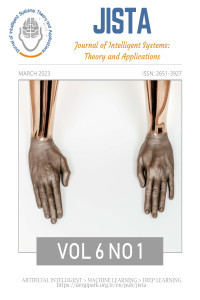Recognition of Sign Language Letters Using Image Processing and Deep Learning Methods
Sign Language, Image Processing, Deep Learning, Image Analysis, Object Detection
Recognition of Sign Language Letters Using Image Processing and Deep Learning Methods
Sign Language, Image Processing, Deep Learning, Image Analysis, Object Detection,
___
- [1]- Ashish S. N., Aarti G. A., 2016. Sign language recognition using image based hand gesture recognition techniques. 2016 Online International Conference on Green Engineering and Technologies (IC-GET), Coimbatore/India, 19 November 2016, 1-5. Accessed: 04.02.2020
- [2]- Sandhya, A., Ananya R., 2018. Recognition of sign language using image processing. International Journal of Business Intelligence and Data Mining, 13(1/2/3):163. doi:10.1504/IJBIDM.2018.088428.
- [3]- Gaikwad, S., Shetty, A., Satam, A., Rathod, M., Shah, P., 2019. Recognition of American Sign Language using image processing and machine learning. International Journal of Computer Science and Mobile Computing, 8(3), 352-357.
- [4]- Tamura, S., Kawasaki, S., 1988. Recognition of sign language motion images. Pattern Recognition, 21(4), 343-357.
- [5]- Kumarage, D., Fernando, S., Fernando, P., Madushanka, D., Samarasinghe, R., 2011. Real-time sign language gesture recognition using still-image comparison & motion recognition. 2011 6th International Conference on Industrial and Information Systems, Kandy/Sri Lanka, 10 October 2011, 169-174. Accessed: 10.01.2020
- [6]- Tan Y.S., Lim K.M., Tee C., Lee C., 2020. Convolutional neural network with spatial pyramid pooling for hand gesture recognition. Neural Computing and Applications, Published online: 15 September 2020, doi:10.1007/s00521-020-05337-0.
- [7]- Pramada S., Saylee D., Pranita N., Samiksha N., Vaidya S., 2013. Intelligent sign language recognition using image processing. IOSR Journal of Engineering (IOSRJEN), 3(2), 45-51.
- [8]- Shivashankara S., Srinath S., 2018. An American sign language recognition system using bounding box and palm features extraction techniques. International Journal of Recent Technology and Engineering (IJRTE), 7(4s): 492-505.
- [9]- Vargas L.P., Barba L., Torres C.O., Mattos L., 2011. Sign Language Recognition System using Neural Network for Digital Hardware Implementation. Journal of Physics: Conference Series, 274 (2011) 012051, 1-7, doi: 10.1088/1742-6596/274/1/012051.
- [10]- Shaoqing R., Kaiming H., Ross G., Jian S., 2017. Faster R-CNN: Towards Real-Time Object Detection with Region Proposal Networks. IEEE Transactions on Pattern Analysis and Machine Intelligence, 39(6), 1137-1149.
- Başlangıç: 2018
- Yayıncı: Özer UYGUN
Küme Birleşimli Sırt Çantası Probleminin Adaptif Yapay Arı Kolonisi Algoritması ile Çözümü
Rafet DURGUT, İlim Betül HACIOĞLU, Mehmet AYDİN
Recognition of Sign Language Letters Using Image Processing and Deep Learning Methods
Ali ÖZTÜRK, Melih KARATEKİN, İsa Alperen SAYLAR, Nazım Bahadır BARDAKCI
Performance Evaluation of WBANs MAC Protocols in Different dBm and OMNet++
Zafer ALBAYRAK, Hatem MUSA, Muhammet ÇAKMAK
Makine Öğrenmesi Algoritmaları Kullanarak Erken Dönemde Diyabet Hastalığı Riskinin Araştırılması
Halil İbrahim DEMİR, Caner ERDEN, Abdullah KÖKÇAM, Alper GÖKSU
Tüketici Yorumları Üzerine Bir Metin Madenciliği ve Veri Boyutu İndirgeme Yaklaşımı
Classifier Selection in Resource Limited Hardware: Decision Analysis and Resolution Approach
